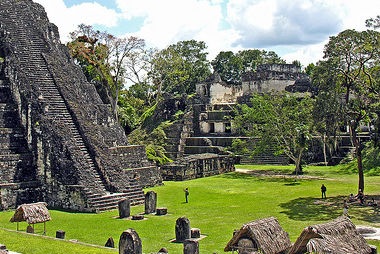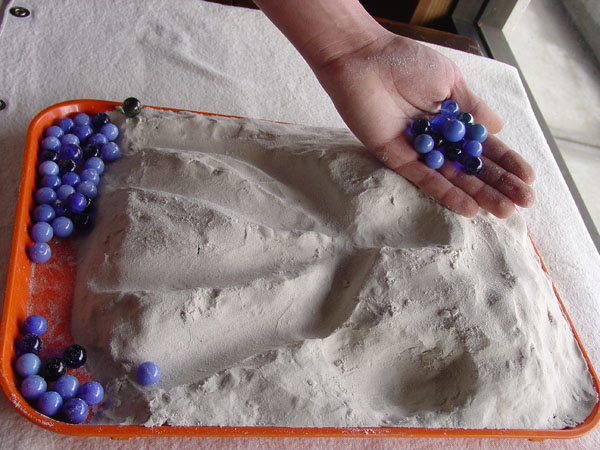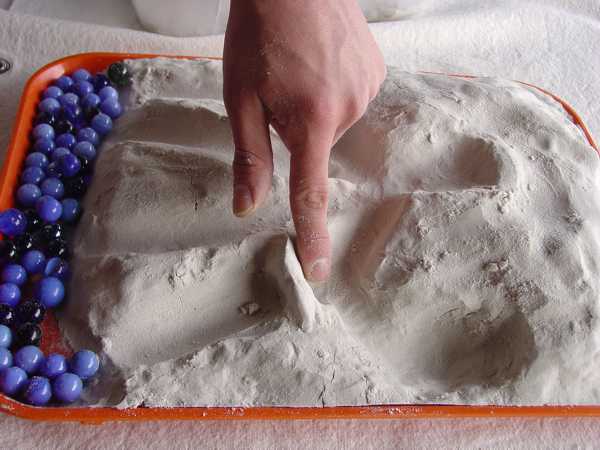|
Designing a system to capture water for use during droughts. |
SIXTH GRADE -
HUMAN IMPACT
OBJECTIVE
·
Exploring historical impact of drought on civilizations
·
Engineering a way to retain water
VOCABULARY
·
drought
·
dam
·
well
·
levee
·
aqueduct
reservior
MATERIALS
·
Shape
it dough (plastic sticks, spoon, or other appropriate tool)
·
Marbles
·
Tray
·
Dr.
Drippy
by Michael Doherty
·
powerpoint
"Human Impact"
web/membership/powerpoints/6th lesson 6
human_impact_from_climate_change.pptx
ONLINE READINGS
Earth Sciences – Interaction of Oceans and Atmosphere
https://msnucleus.org/membership/html/jh/earth/weather/lesson2/weather2a.html
BACKGROUND
Water is our lifeline that bathes us and feeds us. In ancient cultures
water represented the very essence of life. The Romans were the first to
pipe water into their growing cities, especially with their aqueducts.
The movement of water is controlled by gravity and any obstruction
that can affect the flow. They
also realized that sewage water could cause damage to their people,
and needed to be removed from large areas of people.
Water has
played a role not only in the history of countries, but in religion,
mythology, and art. Water in many religions cleanses the soul through holy
water. For example, the water at Lourdes, France is thought by many
religions to be sacred water with healing powers. In Egyptian mythology,
the Nu was the beginning of everything and represented water. It brought
life to their people, but in drought, produced chaos.
Civilizations
have engineered ways in which they can store water.
They would build levee or dams to control the flow of water.
Levee’s can prevent floating which dams are built to save water
from flowing away to be used when there is no water.
Civilizations have used wells to store water.
Water
has always been perceived as a gift from the gods as it rained from the
heavens.
Changes in climate has brought down civilizations.
Long term drought cycles have forced people to move to new areas or
caused wars. Those cultures
that prepared well for drought and control of water, lasted longer.
PROCEDURE:
1.
Read
Mr. Drippy to review the water cycle.
Notice the term infiltration.
Water can move into the ground through porous rocks.
They also may not know the term “transpiration”.
Transpiration is the process where plants absorb water through the roots
and then give off water vapor through pores in their leaves.
2.
Ask students, why do we need water?
How have people tried to control water?
3.
Go over the powerpoint “Watersheds and Controlling Water”.
Emphasize that fresh water is a scarce resource.
4.
 Students use “Shape It” clay to
mold how water can flow downhill.
They need to create a path for the water to flow down controlled by
gravity. Use a marble to see
if their structure actually works.
If not have students mold rivers and creeks until the marble flows
to the bottom. Students use “Shape It” clay to
mold how water can flow downhill.
They need to create a path for the water to flow down controlled by
gravity. Use a marble to see
if their structure actually works.
If not have students mold rivers and creeks until the marble flows
to the bottom.
5.
After
they use gravity to make a watershed where the water flows easily,
challenge the students to create areas where you can trap water.
For example a dam will allow water to pool, but then you can create
an artificial lake (reservoir) if the water can flow back.
Please note the bottom on the “lake” would need a low or flow rate,
so the water is not lost to the ground.
Roll the marble and see if it works.
It will probably take several designs to get it work correctly.
 6.
Next have students use popsicle sticks to make “aqueducts” and canals to
transport water from one hill to the next to move water from the mountains
to the city, like the ancient Romans.
Again, they should use marbles to see if the “water” moves where
they want it to or if they need to correct their engineering. If you have
large trays such as for cooking a turkey, teams of students can create
complex waterways with terraces, mountains, canals, aqueducts and cities.
They can use the boxes of plastic items to make cities or other
features.If there is time, the groups can present their water control
models to the class, 6.
Next have students use popsicle sticks to make “aqueducts” and canals to
transport water from one hill to the next to move water from the mountains
to the city, like the ancient Romans.
Again, they should use marbles to see if the “water” moves where
they want it to or if they need to correct their engineering. If you have
large trays such as for cooking a turkey, teams of students can create
complex waterways with terraces, mountains, canals, aqueducts and cities.
They can use the boxes of plastic items to make cities or other
features.If there is time, the groups can present their water control
models to the class,

|




